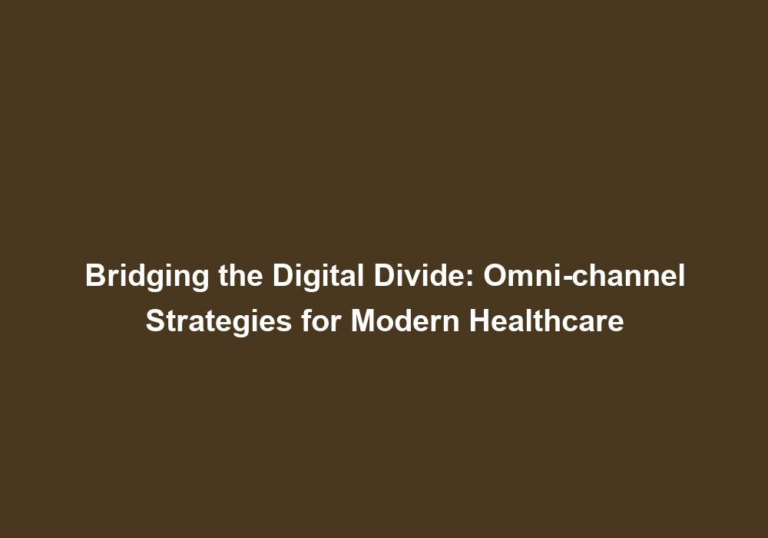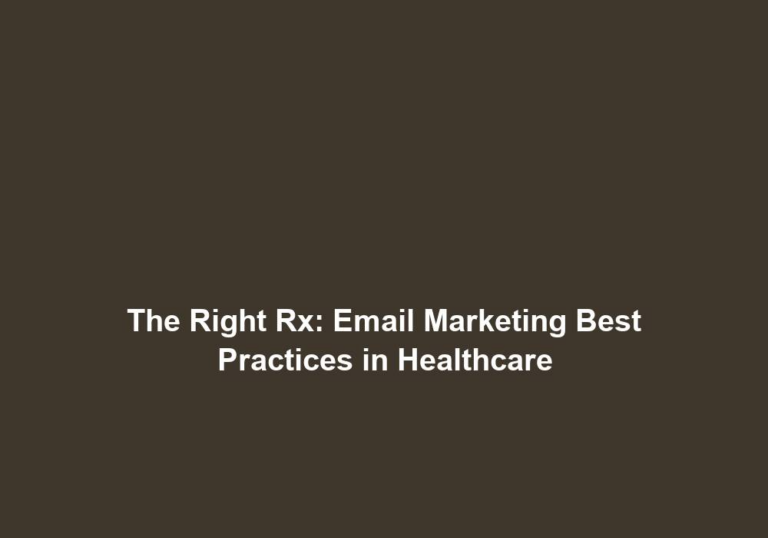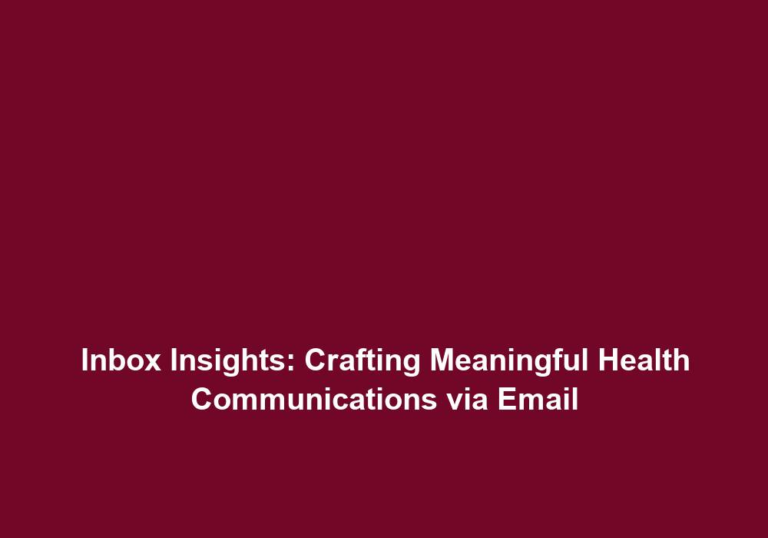Viral Vitality: Harnessing Social Media for Health Engagement and Education
In today’s digital age, social media has revolutionized the way we communicate, connect, and share information. It has become an integral part of our daily lives, influencing various aspects including health engagement and education. This article will explore the power of social media in promoting health awareness, engaging individuals, and fostering educational opportunities.
The Role of Social Media in Health Engagement
- Increased Accessibility: Social media platforms have made health information easily accessible to individuals from all walks of life. With just a few clicks, people can access valuable resources, research studies, and expert opinions on various health topics. This accessibility allows individuals to take charge of their health by making informed decisions.
- Social media platforms provide a vast array of health resources, including articles, videos, and websites, that can be easily accessed by anyone with an internet connection.
- By removing barriers to accessing health information, social media empowers individuals to educate themselves on various health topics and make informed decisions about their well-being.
- The ease of access to health information on social media also encourages individuals to stay updated on the latest research, preventive measures, and treatment options, leading to improved health outcomes.
- Community Building: Social media platforms provide a space for individuals facing similar health challenges to connect and support one another. Through groups, pages, and hashtags, people can share experiences, seek advice, and find solace in a supportive community. This sense of belonging can foster motivation, empowerment, and engagement in health-related activities.
- Online communities on social media platforms allow individuals to connect with others who share similar health concerns, creating a sense of belonging and understanding.
- These communities provide a safe space for individuals to express their concerns, ask questions, and seek advice from peers who may have experienced similar health issues.
- The support and encouragement received from these communities can motivate individuals to take proactive steps towards managing their health, leading to improved overall well-being.
- Health Campaigns and Awareness: Social media serves as a powerful tool for spreading health-related campaigns and raising awareness. Organizations and healthcare professionals can disseminate vital information about preventive measures, diseases, and available treatments to a wide audience. The viral nature of social media amplifies the reach and impact of such campaigns, contributing to a healthier society.
- Social media allows health organizations and professionals to reach a vast audience quickly and effectively, increasing the reach and impact of health campaigns.
- By utilizing engaging content, such as videos, infographics, and interactive posts, health campaigns on social media can capture the attention of users and encourage them to share the information with their networks.
- The viral nature of social media enables health campaigns to reach individuals who may not have been exposed to such information through traditional channels, resulting in increased awareness and behavior change.
Harnessing Social Media for Health Education
- Educational Content Creation: Social media platforms offer a diverse range of formats to deliver health education content. From infographics and videos to blog posts and podcasts, healthcare professionals and organizations can create engaging and informative content to disseminate knowledge. By using creative visuals, simplified language, and storytelling techniques, complex health concepts can be made more accessible and understandable to the general public.
- Health education content on social media can be presented in various formats to cater to different learning styles and preferences.
- Infographics and videos can visually convey complex health information in a simplified and engaging manner, making it easier for the audience to comprehend and remember.
- Blog posts and podcasts allow healthcare professionals to provide in-depth explanations and discussions on specific health topics, offering valuable insights to the audience.
- Interactive Webinars and Live Sessions: Platforms like Facebook Live, Instagram Live, and YouTube Live enable healthcare professionals to conduct interactive webinars and live sessions. These sessions allow real-time engagement with the audience, fostering a sense of interactivity, trust, and credibility. Participants can ask questions, seek clarification, and gain deeper insights into health topics from subject matter experts.
- Interactive webinars and live sessions on social media provide a unique opportunity for healthcare professionals to directly engage with their audience in real-time.
- Participants can ask questions, share their experiences, and receive immediate responses, creating a dynamic and interactive learning environment.
- The live format of these sessions enhances the credibility of the healthcare professionals, as it allows the audience to witness their expertise and knowledge firsthand.
- Collaboration with Influencers: Social media influencers, particularly those in the health and wellness space, possess a massive reach and influence over their followers. Collaborating with these influencers can be a powerful way to promote health education and engage a wider audience. By partnering with influencers, healthcare professionals can leverage their expertise, credibility, and audience trust to disseminate accurate health information and debunk myths.
- Social media influencers have established trust and credibility among their followers, making them effective partners for healthcare professionals to promote health education.
- By collaborating with influencers, healthcare professionals can reach a broader audience who may not actively seek health information through traditional channels.
- Influencers can use their platform to share accurate health information, debunk myths, and promote evidence-based practices, thereby positively influencing the health behaviors of their followers.
Best Practices for Social Media Health Engagement and Education
- Accuracy and Credibility: The proliferation of misinformation on social media poses a significant challenge in the health domain. It is crucial for healthcare professionals to ensure the accuracy, credibility, and evidence-based nature of the information they share. Fact-checking, citing reliable sources, and providing references are essential practices to maintain authenticity and trustworthiness.
- Healthcare professionals should critically evaluate the information they share on social media, ensuring that it comes from reputable sources and is supported by scientific evidence.
- Fact-checking is crucial to prevent the spread of false or misleading health information, which can have detrimental effects on individuals’ well-being.
- Citing reliable sources and providing references allows the audience to verify the information and further explore the topic if desired, promoting transparency and trust.
- Engagement and Interaction: To maximize the impact of health engagement and education on social media, active participation and interaction with the audience are key. Responding to comments, addressing queries, and initiating discussions can establish a sense of community and foster a two-way communication channel. This engagement builds trust, encourages knowledge sharing, and enhances the overall learning experience.
- Healthcare professionals should actively engage with their audience by responding to comments, acknowledging feedback, and answering questions.
- Initiating discussions on health topics encourages the audience to share their experiences, perspectives, and additional insights, creating a collaborative learning environment.
- By fostering a two-way communication channel, healthcare professionals can build trust and establish themselves as approachable sources of reliable health information.
- Tailoring Content to Target Audience: Understanding the target audience is crucial when creating health content for social media. By tailoring content to meet the needs, preferences, and language proficiency of the audience, healthcare professionals can ensure better engagement and comprehension. Utilizing analytics and audience insights can provide valuable data to refine content strategies and deliver personalized health information.
- Healthcare professionals should conduct audience research to understand the demographics, interests, and information needs of their target audience.
- By tailoring the content to match the preferences and language proficiency of the audience, healthcare professionals can increase the likelihood of engagement and comprehension.
- Analytics and audience insights provided by social media platforms offer valuable data on content performance, audience demographics, and engagement metrics, enabling healthcare professionals to refine their content strategies and deliver personalized health information effectively.
In conclusion, social media has emerged as a powerful tool for health engagement and education. Leveraging its accessibility, community-building capabilities, and viral nature, healthcare professionals and organizations can create a positive impact on public health. By adhering to best practices, producing high-quality content, and actively engaging with the audience, social media can be harnessed to revolutionize health education and empower individuals in making informed decisions about their well-being.






